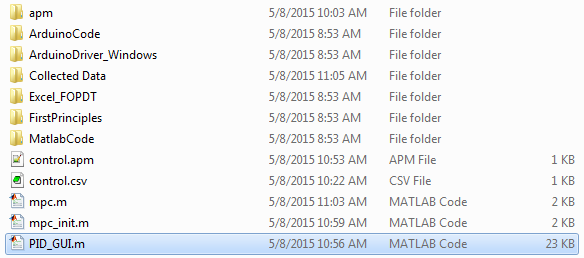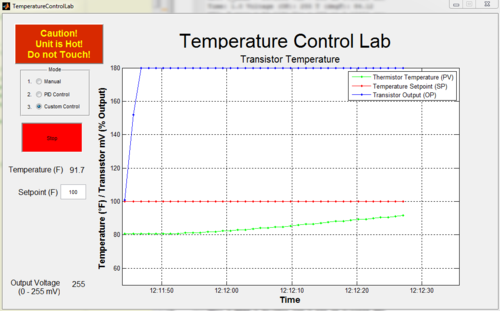Arduino Lab for Dynamic Optimization
Main.ArduinoLab History
Hide minor edits - Show changes to markup
(:html:) <iframe width="560" height="315" src="//www.youtube.com/embed/sj-Ld-mxZoU?rel=0" frameborder="0" allowfullscreen></iframe> (:htmlend:)
Multiple Input, Multiple Output (MIMO)
Additional Content
Simulate Energy Balance with MATLAB
Energy Balance with MATLAB Simulation
Featured in CACHE News, December 2014.
Featured in CACHE News, December 2014.
Solve and Linearize an Energy Balance Model with MATLAB
Simulate Energy Balance with MATLAB
Dynamic Optimization for an Arduino Temperature Regulator
(:title Arduino Lab for Dynamic Optimization:) (:keywords Arduino, Python, MATLAB, nonlinear control, model predictive control, moving horizon estimation, Kalman filter:) (:description Arduino estimation and control with sample files and instructions to build a bench-scale device for transistor based heated temperature regulation.:)
Featured in CACHE News, December 2014.
Dynamic Optimization for an Arduino Temperature Regulator
(:html:) <iframe width="560" height="315" src="//www.youtube.com/embed/nn2qgYykdy0?rel=0" frameborder="0" allowfullscreen></iframe> (:htmlend:)
This lab is an application of feedback control for a temperature control device. Complete instructions are available below in the temperature control lab description. The lab can be run on personal computers or on workstations in the UO Lab.

Students have an opportunity to use this lab to learn principles of system dynamics, estimation, and model predictive control. In particular, this lab reinforces:
- The difference between manual and automatic control
- Step tests to generate dynamic data for empirical modeling
- Dynamic modeling with first principles
- Tune a moving horizon estimator
- Tune a model predictive controller
- Dynamic data reconciliation

The three important elements for this lab are the measurement device (thermistor temperature sensor), an actuator (voltage to the transistor), and capability to perform computerized control (USB interface). At maximum output the transistor dissipates 3.1 W of power with a voltage of 8.9 V and current of 0.35 A. The heat generated by the transistor transfers by radiation, convection, and conduction to the temperature sensor.
Additional Content
Solve and Linearize an Energy Balance Model with MATLAB
(:html:) <iframe width="560" height="315" src="//www.youtube.com/embed/w9gwRFCbgNA" frameborder="0" allowfullscreen></iframe> (:htmlend:)


